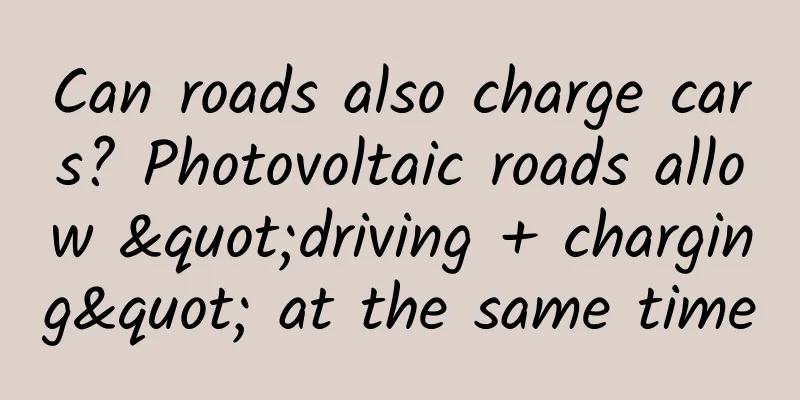Can roads also charge cars? Photovoltaic roads allow "driving + charging" at the same time

|
□ Right to speak Recently, the Tarim Oilfield Photovoltaic Desert Highway "Zero Carbon" Demonstration Project, the longest photovoltaic irrigation and sand control project in my country, has generated more than 5 million kWh of green electricity. This photovoltaic highway is the first zero-carbon desert highway in my country, achieving the dual effects of sand control and environmental protection. Photovoltaic highways are roads that directly lay photovoltaic power generation components that meet vehicle traffic conditions on the road surface to achieve solar power generation and other related functions. This type of road surface consists of a light-transmitting concrete pavement layer, a photovoltaic panel layer, and an insulation layer. After strict testing, the technical indicators and traffic safety factor of photovoltaic highway pavements have exceeded those of traditional asphalt pavements. With the increasing popularity of new energy vehicles, the road surface alone can solve the endurance problem, and its value is self-evident. With the implementation of the "dual carbon" strategy, the photovoltaic industry has quickly entered thousands of industries and become a typical application scenario of "photovoltaic +". As one of the main sources of "carbon emissions", the transportation sector accounts for more than 10% of my country's total carbon emissions. Compared with some countries in Europe and the United States, my country's transportation industry has a fast growth rate of carbon emissions and great potential for emission reduction. In particular, road transportation accounts for more than 85% of the country's total transportation carbon emissions. The use of renewable energy such as photovoltaics can effectively reduce carbon emissions in transportation, thereby promoting the green and low-carbon transformation of the industry, which is of great significance for development. The "Main Points for the Work of National Highway Service Areas in 2024" issued by the Ministry of Transport clearly proposes to explore and innovate near-zero-carbon service areas, implement relevant work requirements for green and low-carbon development in the transportation and highway industries around the "dual carbon" goals, promote the construction of near-zero-carbon service areas, and promote the construction of photovoltaic infrastructure in service areas. As early as 2017, the world's first highway photovoltaic pavement test section with completely independent intellectual property rights was officially opened to traffic in Jinan. Under the nationwide "dual carbon" action, provincial highway groups have explored various forms of integration of photovoltaics and transportation. According to incomplete statistics, more than 20 highway groups in my country have already had application cases, such as the "transportation + energy" composite project in Tangshan City, Hebei Province and the Biwei Expressway Distributed Photovoltaic Project in Guizhou Province. The construction of the Shandong Zaohe Expressway Full-area Transportation Energy Integration Demonstration Project, the first domestic transportation energy integration demonstration project carried out by Gezhouba Group Transportation Investment Co., Ltd., is in full swing. From a foreign perspective, although the US "Solar Highway" project has been successful in technology demonstration, it has not been widely promoted due to cost issues. This reminds us that while pursuing technological innovation, we must consider economic feasibility and market acceptance. China's photovoltaic highway projects have made significant progress in scale and technology, such as road cooling functions, additional landscape functions, waste heat utilization, electricity utilization, human-road information interaction, vehicle-road information interaction, etc., but how to solve problems such as cost, maintenance, and intelligent management to improve the performance of photovoltaic panels is still a problem that needs to be solved. Imagine that in the near future, when the first rays of the sun penetrate the morning mist and illuminate the winding highway, an ordinary family car slowly drives into a photovoltaic highway known as the "Sunshine Road". As the wheels roll, the sun shines through the specially made light-transmitting concrete road surface, activating the photovoltaic panels hidden under the road surface. These panels not only convert solar energy into electrical energy, but also transmit this electrical energy to roadside storage stations, which are as convenient as gas stations, providing clean solar energy for the bustling passing vehicles. Photovoltaic highway, the dream is shining into reality. (The author is a member of Anhui Science Writers Association) |
<<: The powerful "king of soil": the "universal soil" in ultra-deep drilling projects
Recommend
It took 270 hours to copy a classic sculpture. Can robots replace Michelangelo?
© Through Eternity Tours Leviathan Press: Michela...
What operations are involved in after-sales maintenance of game server rental and hosting?
What operations are involved in after-sales maint...
What does an operational plan that satisfies the boss and is valuable look like? (superior)
What does an operational plan that satisfies the ...
I believe my friends recommend Wuhan tea tasting, high-quality sea selection, takeaway, and tea drinking. Share
Wuhan High-Quality Tea Tasting Audition (185~7360~...
How do computers send and receive information?
How do two computers communicate with each other?...
How do big self-media accounts make money?
The fans of emotional self-media are ordinary peo...
On the development of "Android" in the next ten years
Electronic products, especially the mobile phone ...
Interview with Ironsource CEO Tomer Bar-Zeev: The internationalization of Internet products
[[126198]] With the development of the Internet a...
Attention! Many people suffer from this habit that hurts their knees!
As a chosen worker, you Are you wondering: Sittin...
Strategies for creating 10w+ article titles for new media operations!
A title that cannot be understood in one second i...
What is the best time to eat breakfast? Is it harmful to take a nap? You will no longer be troubled after reading this
After getting up in the morning, a new day begins...
Bacteria are so "fertile", will the earth be occupied by them one day?
Produced by: Science Popularization China Author:...
The "Dianzan 2022 Science Popularization China" announcement ceremony was successfully held
On March 26, 2023, the "Dianzan 2022 Science...
[Collection] The secrets behind Apple's search ads are revealed, with the most complete and detailed explanation and step-by-step setup tutorial (official video attached)
The WWDC2016 Search Ads session video and PPT have...
For information flow promotion, which channel is currently having the best effect?
2016 is the explosive year for information flow a...








![[Smart Farmers] Although “earthy”, “rich”, protecting the world in the soil](/upload/images/67f242f10c06a.webp)
